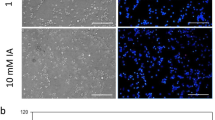Abstract
2,4-Dichlorophenoxyacetic acid (2,4-D) is one of the most widely used herbicides due to its relatively moderate toxicity and to its biodegrad-ability in the soil. In toxic concentrations, 2,4- D displays strong neurotoxicity, partly due to generation of free radicals. Since melatonin has remarkable antioxidant properties, the objective of this study was to assess to what extent it was effective in preventing the 2,4-D effect on redox balance of rat cerebellar granule cells (CGC) in vitro. Cellular viability, generation of reactive oxygen species (ROS) and reactive nitrogen species (RNS), reduced glutathione (GSH) levels, and the activities of the antioxidant enzymes Cu/ Zn-superoxide dismutase (Cu/Zn-SOD), Mn-SOD, selenium-glutathione peroxidase (Se-GPx) and catalase (CAT) were measured in CGC exposed to 2,4-D and/or melatonin for 48 h. In CGC cultures exposed to 2,4-D, cell viability, GSH levels and CAT activity decreased significantly whereas ROS generation and Se-GPx activities were augmented. Except for Se-GPx activity, all these changes were counteracted by the concomitant addition of 0.1 or 0.5 mM melatonin. In addition, incubation of CGC with melatonin alone resulted in augmentation of cell viability, GSH levels and Se-GPx activity. RNS generation and SOD activity remained unaffected by either treatment. Since melatonin was able to counteract most of redox changes produced by 2,4-D in CGC in culture, the experimental evidence reported further support the efficacy of melatonin to act as a neuroprotector.
Similar content being viewed by others
Abbreviations
- 2,4-D:
-
2,4-Dichlorophenoxyacetic acid
- CAT:
-
catalase
- CGC:
-
Cerebellar granule cells
- CNS:
-
Central nervous system
- Cu/Zn-SOD:
-
Cu/Zn-superoxide dismutase
- DCF:
-
2′,7′-dichlorofluorescein
- DCFH:
-
2′7′-dichlorofluorescin
- GSH:
-
reduced glutathione
- Mn-SOD:
-
Mn-superoxide dismutase
- MTT:
-
3-(4,5-dimethylthiazol-2-eyl)-2,5-diphenyl tetrazolium bromide
- NMDA:
-
N-methyl-D-aspartate
- NO:
-
nitric oxide
- RNS:
-
reactive nitrogen species
- ROS:
-
reactive oxygen species
- Se-GePx:
-
selenium-glutathione peroxidase
References
Beers RF and IW Sizer (1951) A spectrophotometric method for measuring the breakdown of hydrogen peroxide by cata-lase.J. Biol. Chem. 195, 133–140.
Bortolozzi A, AM Evangelista de Duffard, F Dajas, R Duffard and R Silveira (2001) Intracerebral administration of 2,4-diclorophenoxyacetic acid induces behavioral and neuro-chemical alterations in the rat brain.Neurotoxicology 22, 221–232.
Bradberry SM, BE Watt, AT Proudfoot and JA Vale (2000) Mechanisms of toxicity, clinical features, and management of acute chlorophenoxy herbicide poisoning: a review.J. Toxicol. Clin. Toxicol. 38, 111–122.
Brusco A, JP Saavedra, G Garcia, P Tagliaferro, AM Evangelista de Duffard and R Duffard (1997) 2,4-dichlorophenoxyacetic acid through lactation induces astrogliosis in rat brain.Mol. Chem. Neuropathol. 30, 175–185.
Cardinali DP, RE Rosenstein, DA Golombek, HE Chuluyan, B Kanterewicz, MM Del Zar and MI Vacas (1991) Melatonin binding sites in brain: single or multiple?Adv. Pineal Res. 5, 159–165.
De Moliner KL, AM Evangelista de Duffard, E Soto, R Duffard and AM Adamo (2002) Induction of apoptosis in cerebellar granule cells by 2,4-dichlorophenoxyacetic acid.Neurochem. Res. 27, 1439–1446.
Emerit J, M Edeas and F Bricaire (2004) Neurodegenerative diseases and oxidative stress.Biomed. Pharmacother. 58, 39–46.
Gallo V, R Suergiu and G Levi (1987) Functional evaluation of glutamate receptor subtypes in cultured cerebellar neurones and astrocytes.Eur. J. Pharmacol. 138, 293–297.
Giusti P, M Gusella, M Lipartiti, D Milani, W Zhu, S Vicini and H Manev (1995) Melatonin protects primary cultures of cerebellar granule neurons from kainate but not fromN- methyl-D-aspartate excitotoxicity.Exp. Neurol. 131, 39–46.
Kaioumova D, C Susal and G Opelz (2001) Induction of apoptosis in human lymphocytes by the herbicide 2,4-dichlorophenoxyacetic acid.Hum. Immunol. 62, 64–74.
McCord JM and I Fridovich (1969) The utility of superoxide dismutase in studying free radical reactions. I. Radicals generated by the interaction of sulfite, dimethyl sulfoxide, and oxygen.J. Biol. Chem. 244, 6056–6063.
Miranda KM, MG Espey and DA Wink (2001) A rapid, simple spectrophotometric method for simultaneous detection of nitrate and nitrite.Nitric Oxide 5, 62–71.
Myhre O, TA Vestad, E Sagstuen, H Aarnes and F Fonnum (2000) The effects of aliphatic (n-nonane), naphtenic (1,2, 4-trimethylcyclohexane), and aromatic (1,2,4-trimethylben-zene) hydrocarbons on respiratory burst in human neutrophil granulocytes.Toxicol. Appl. Pharmacol. 167, 222–230.
Paglia DE and WN Valentine (1967) Studies on the quantitative and qualitative characterization of erythrocyte glutathi-one peroxidase.J. Lab. Clin. Med. 70, 158–169.
Pandi-Perumal SR, V Srinivasan, GJM Maestroni DP Cardinali, B Poeggeler and R Hardeland (2006) Melatonin: nature’s most versatile biological signal?FEBS J. 273, 2813–2838.
Park JS, M Wang, SJ Park and SH Lee (1999) Zinc finger of replication protein A, a non-DNA binding element, regulates its DNA binding activity through redox.J. Biol. Chem. 274, 29075–29080.
Savill RM, PJ Scotting and B Coyle (2005) Strategies to investigate gene expression and function in granule cells.Cerebellum 4, 271–278.
Srinivasan V, SR Pandi-Perumal, GJ Maestroni, AI Esquifino, R Hardeland and DP Cardinali (2005) Role of melatonin in neurodegenerative diseases.Neurotox. Res. 7, 293–318.
Teixeira MC, JP Telo, NF Duarte and I Sa-Correia (2004) The herbicide 2,4-dichlorophenoxyacetic acid induces the generation of free-radicals and associated oxidative stress responses in yeast.Biochem. Biophys. Res. Commun. 324, 1101–1107.
Thomas T, F Rauscher, R Sanders, J Veltman and JB WatkinsIII (2000) Effects of aldose reductase inhibitors on anti-oxidant defense in rat and rabbit liver.Toxicol. Sci. 53, 145–149.
Tricoire H, M Moller, P Chemineau and B Malpaux (2003) Origin of cerebrospinal fluid melatonin and possible function in the integration of photoperiod.Reprod. Suppl. 61, 311–321.
Tuschl H and C Schwab (2003) Cytotoxic effects of the herbicide 2,4-dichlorophenoxyacetic acid in HepG2 cells.Food Chem. Toxicol. 41, 385–393.
Author information
Authors and Affiliations
Corresponding author
Rights and permissions
About this article
Cite this article
Bongiovanni, B., De Lorenzi, P., Ferri, A. et al. Melatonin decreases the oxidative stress produced by 2,4-dichlorophenoxyacetic acid in rat cerebellar granule cells. neurotox res 11, 93–99 (2007). https://doi.org/10.1007/BF03033388
Received:
Revised:
Issue Date:
DOI: https://doi.org/10.1007/BF03033388




